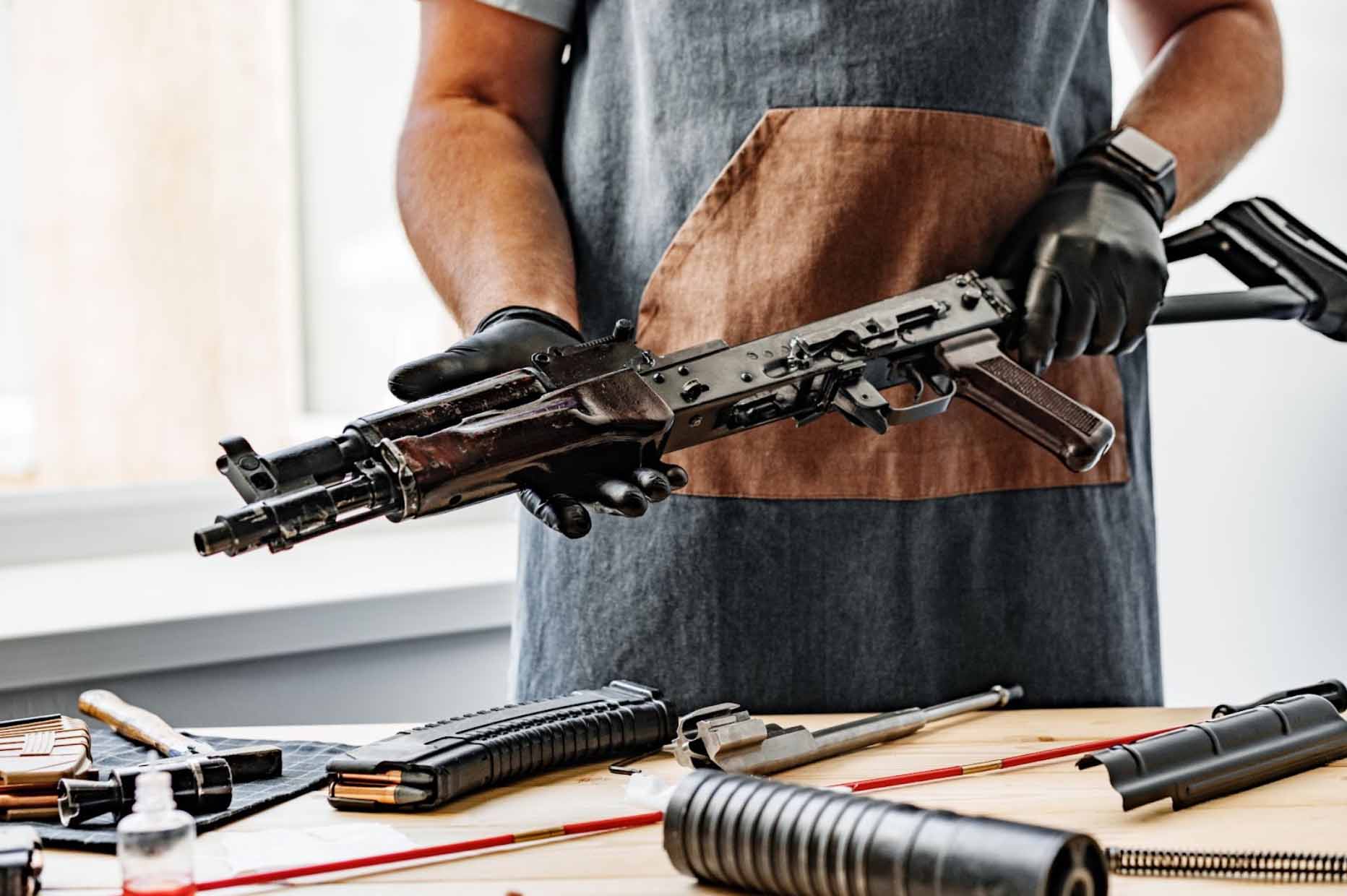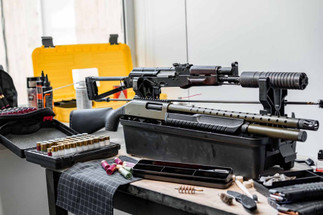Jun 24th 2024
The Basics of Gun Customization
The Basics of Gun Customization
Gun customization is a thriving aspect of firearm ownership. It allows enthusiasts to personalize their weapons to suit their preferences and needs. It combines aesthetics, performance, and functionality to enhance the overall gun experience. Understanding the basics of customization helps gun owners make informed decisions that improve their firearms.
Understanding Gun Customization
Gun customization involves modifying a firearm to meet specific preferences or requirements. Customization can range from simple aesthetic changes to complex modifications that improve performance and functionality. The reasons for customizing guns are varied, including personal expression, improving accuracy, and enhancing comfort and usability.
Types of Gun Customization
Gun customization can be broadly categorized into aesthetic changes, performance enhancements, and functional modifications. Each type serves a distinct purpose, catering to gun owners' varied needs and preferences. Understanding these categories helps make informed choices about the most beneficial modifications.
Aesthetic Customization
Aesthetic customization focuses on a firearm's visual appeal. It can include adding custom finishes, engraving, or changing the color scheme. Some owners opt for intricate designs, while others prefer a sleek, professional look. Aesthetic changes can make a gun unique and reflect the owner's personality. Additionally, aesthetic modifications can serve as conversation starters and showcase the owner's craftsmanship.
Performance Enhancement
Performance enhancement customization aims to improve the firearm's accuracy, reliability, and handling. That might involve upgrading internal components like triggers, barrels, or recoil systems. Competitive shooters or those looking to get the best performance from their firearm often choose enhancements. Performance upgrades can significantly impact shooting efficiency and consistency. Such modifications usually require a deeper understanding of the firearm's mechanics.
Functional Customization
Functional customization involves modifications that improve a gun's usability. It includes adding new grips, adjusting the stock, or incorporating better sights and optics. These changes can make a firearm more comfortable to use and can be tailored to the shooter's specific needs. Functional upgrades are particularly beneficial for adapting the gun to different shooting conditions or ergonomic requirements. Ensuring that functional customizations are appropriately installed can enhance the overall shooting experience.
Each type of customization offers unique benefits, allowing gun owners to personalize their firearms to their specific tastes and requirements. By exploring aesthetic, performance, and functional modifications, owners can create guns that match their style and taste.
Popular Gun Customization Options
Gun customization offers various options to enhance a firearm's aesthetics and performance. Each customization option provides specific benefits tailored to the user's needs. Understanding these options helps gun owners choose the most suitable modifications for their firearms.
Grips
Grips are a standard customization option because they directly affect how comfortably a gun fits in the hand. Custom grips can be made from various materials, including wood, rubber, and polymer. They can be textured for a better grip or shaped to fit the user's hand perfectly. Upgrading grips can improve control and reduce fatigue during extended use, making shooting more enjoyable and enhancing accuracy.
Triggers
Upgrading the trigger is a popular customization for improving a gun's performance. A custom trigger can reduce the pull weight, provide a crisper break, and enhance shooting accuracy. Various trigger styles are available, from single-stage to two-stage, each offering different benefits. Custom triggers can also provide a smoother pull and faster reset, which can be particularly beneficial for competitive shooters seeking precision.
Sights and Optics
Sights and optics are crucial for improving shooting accuracy. Upgrading to high-quality sights or adding a red dot or holographic sight can make aiming faster and more precise. Scopes are also a popular addition for long-range shooting, providing better target acquisition and accuracy. Modern optics can enhance visibility in low-light conditions, ensuring better performance across shooting environments.
Barrels
Changing the barrel can significantly impact a firearm's performance. Custom barrels can improve accuracy, reduce weight, and alter the balance of a gun. Options include match-grade barrels for precision shooting and shorter barrels for improved maneuverability. High-quality barrels can also enhance durability and heat dissipation, which are essential for maintaining consistent performance during extended use.
Stocks
Stocks are vital in rifles and shotguns; personalizing them can improve comfort and control. Adjustable stocks allow for a better fit to the shooter's body, while specialized stocks can reduce recoil and enhance stability. Custom stocks can be made from various materials, such as wood, synthetic composites, or metal. The right stock can improve the overall handling and shooting experience.
These popular customization options provide gun owners numerous ways to personalize their firearms. By selecting the appropriate modifications, owners can enhance their guns' form and function, making shooting more enjoyable and efficient.

Customization for Different Types of Guns
Different types of guns offer unique opportunities and challenges for customization. Tailoring modifications to the specific characteristics of handguns, rifles, and shotguns can optimize performance and usability—each type of firearm benefits from distinct kinds of customizations.
Handguns
Handgun customization often focuses on grips, triggers, and sights. Modifications that enhance control and accuracy can benefit compact, easily portable handguns. Standard upgrades include ergonomic grips, night sights, and trigger jobs. Custom slides and barrels can also be added for improved performance. These enhancements can make handguns more suitable for personal defense and competitive shooting.
Rifles
Rifles offer a broad range of customization options. Performance-focused changes like upgrading barrels and triggers are common, as are functional additions like scopes and bipods. Custom stocks can improve handling, and tactical rails can accommodate various accessories. Muzzle devices like compensators and suppressors can also be added. These modifications can significantly enhance a rifle's versatility and effectiveness.
Shotguns
Shotgun customization frequently involves changing stocks and adding sights or optics. Extended magazines, improved chokes, and recoil pads are also popular upgrades. These modifications can make a shotgun more versatile and comfortable to use. Custom forends and tactical accessories like shell carriers are also common. Shotgun customization can enhance hunting, home defense, and competitive shooting performance.
By understanding the customization possibilities for different types of guns, owners can make modifications that best suit their needs. Each firearm type has unique characteristics that can be optimized through thoughtful customization. This approach ensures that the gun performs well in its intended use.
Tools and Materials Needed for Gun Customization
Customizing a firearm requires the right tools and materials. Proper equipment ensures that modifications are done safely and effectively. Knowing the necessary tools and materials is the first step in successful gun customization.
Basic Tools
Basic tools are essential for those new to gun customization. These include screwdrivers, punches, and wrenches specifically designed for firearm maintenance. A gun vise can also help stabilize the firearm during modifications. Basic cleaning supplies like brushes and solvents are also necessary. Having a well-organized tool kit can streamline the customization process.
Advanced Tools
More advanced customization may require specialized tools. These can include precision measuring instruments, torque wrenches, and specialized jigs. Tools for barrel changes, such as action wrenches and barrel vises, are also necessary for specific modifications. Advanced tools like Dremel rotary tools and milling machines can expand customization possibilities. Investing in high-quality tools can ensure better results and reduce the risk of damage.
Materials
Customization often involves using high-quality materials. Options include various metals for components, polymers for grips and stocks, and optical glass for sights. Each material choice can affect the firearm's durability, weight, and performance. Adhesives and coatings are also necessary for specific modifications. Selecting suitable materials can enhance the gun's appearance and functionality.
Having the right tools and materials is crucial for successful gun customization. Proper preparation ensures that modifications are performed safely and accurately. This foundation is essential for achieving desired customization outcomes.

Legal Considerations in Gun Customization
Gun customization must comply with various legal regulations. Both federal and state laws govern what modifications are permissible. Understanding these regulations is essential to ensure that customizations are legal and properly documented.
Federal Regulations
Gun customization must comply with federal regulations. Changing the barrel length, adding suppressors, or other special modifications may require special permits or registrations. The National Firearms Act (NFA) and the Gun Control Act (GCA) are critical legislation governing these modifications. Violating these laws can result in severe penalties. Ensuring compliance with federal regulations is crucial for responsible gun customization.
State and Local Laws
In addition to federal laws, state and local regulations can impact
gun customization. These laws vary widely, so it is essential to research the specific requirements in your area. Some states have restrictions on certain modifications or require particular permits. Local ordinances can also impose additional requirements. Staying informed about state and local laws ensures that customizations are legal and compliant.
Compliance with legal regulations is a fundamental aspect of gun customization. Adhering to federal, state, and local laws helps avoid legal issues and ensures responsible firearm ownership. This legal awareness is essential for any customization project.
Safety Considerations in Gun Customization
Safety is paramount when customizing firearms. Proper safety measures ensure that modifications are performed without risk to the user or others. Following safety guidelines is essential for any customization project.
Safe Handling Practices
Always ensure the gun is unloaded before starting any modification. Use proper safety equipment, such as gloves and eye protection, to prevent injuries. Maintain a clean and organized workspace to avoid accidents. Adhering to safe handling practices minimizes the risk of injury.
Proper Use of Tools
Using tools correctly is crucial for safe customization. Follow the manufacturer's instructions for each tool and avoid using makeshift solutions. Incorrect tool use can damage the firearm and pose safety risks. Regularly inspect tools for wear and tear to ensure they are in good working condition. Proper tool use is essential for both safety and successful customization.
Maintenance Post-Customization
After customizing a firearm, regular maintenance is essential to ensure continued performance and safety. Clean and lubricate the gun according to the manufacturer's recommendations. Check for any signs of wear or damage after modifications. Routine inspections can catch potential issues early and prevent malfunctions. Consistent maintenance ensures that customizations remain effective and safe.
Adhering to safety considerations is vital in gun customization. Proper handling, tool use, and maintenance practices help prevent accidents and ensure the firearm's longevity. Safety should always be a top priority in any customization project.
Common Mistakes in Gun Customization
Avoiding common mistakes can make the gun customization process smoother and more successful. Awareness of potential pitfalls helps gun owners make better decisions and achieve desired outcomes. Learning from common errors can improve the overall customization experience.
Overlooking Compatibility
One of the most common mistakes is overlooking compatibility between components. Not all parts are interchangeable, and using incompatible components can cause malfunctions or damage to the firearm. Always verify that your chosen parts are designed for your specific gun model. Consult manufacturer specifications to ensure compatibility. That helps prevent issues and ensures smooth operation.
Ignoring Ergonomics
Customizing a gun without considering ergonomics can lead to discomfort and decreased performance. Ensure that grips, stocks, and other components fit your body and shooting style. Ergonomic customization can greatly enhance shooting comfort and accuracy. Pay attention to how modifications affect the gun's balance and handling. Ergonomic considerations are essential for a personalized and effective firearm.
Skipping Professional Help
Some modifications may be beyond the skill level of the average gun owner. In such cases, seeking professional help is advisable. Gunsmiths have the expertise and tools to perform complex modifications safely and correctly. Attempting advanced customizations without proper knowledge can lead to costly mistakes. Professional assistance can ensure that customizations are done correctly and safely.
By being aware of these common mistakes, gun owners can better navigate the customization process. Avoiding these pitfalls ensures that modifications are effective and enhance the firearm's performance, leading to a more satisfying and successful customization experience.
Discover all you need to know about gun customization and shooting on our Gunline Shooting blog. Visit now to enhance your firearm knowledge and skills!

